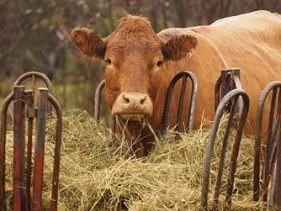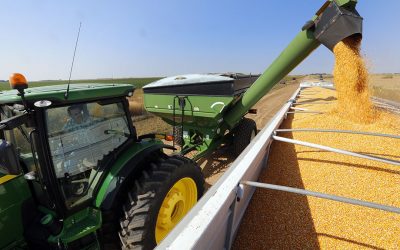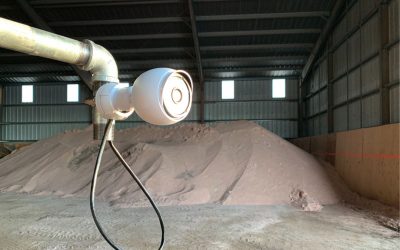Distillers grains to compensate poor hay quality

Byproduct feeds from ethanol plants offer beef herd owners in the US a way to supplement bad hay being baled for winter feed this year.
“Distillers grains can pick up the slack when the hay quality falls short,” said Chris Zumbrunnen, MU Extension regional livestock specialist, Milan, Missouri., who spoke at field days recently held at the University of Missouri Forage Systems Research Center and the Greenley Research Center.
“There is a tremendous amount of high quality product available,” Zumbrunnen said. There will also be plenty of poor quality hay that was harvested late and rained on during haymaking.
Dried distillers grain (DDG) offers around 30% protein, lots of fat and lots of energy, Zumbrunnen said. There are several products available that require different handling methods.
The dried byproduct, which has only 10% moisture, handles and stores easily. However, precautions must be taken in storage. “It can draw moisture and become caked,” Zumbrunnen said. “If you put it in a bin, you might have a hard time getting it out.”
The wet product, with 65% moisture, is less expensive, however Zumbrunnen added a caution. “It’s tough to store and do anything with. You can’t stack it, as it will spread out unless contained.”
Modified wet distillers grain
A new modified wet distillers grain offered by some ethanol plants allows more flexibility and ease in feeding. The modified product is dried down to 50% moisture. It retains its shape and won’t blow away like dry product.
A new modified wet distillers grain offered by some ethanol plants allows more flexibility and ease in feeding. The modified product is dried down to 50% moisture. It retains its shape and won’t blow away like dry product.
”The modified wet product can be fed on the ground or on top of unrolled baled hay. It stays in place,” Zumbrunnen said “Those old cows love it.”
Researchers at the University of Nebraska developed a way to store and feed the wet byproduct. They mixed it with poor quality hay to give it body. The best storage is in a bunker-type silo where it can be packed down.
“You can use poor quality CRP-type hay,” Zumbrunnen said. “You’re just use the hay as filler to give it body.”
A mix of 40 percent hay and 60 percent wet distillers product makes a feed useful for beef-cow herds. “At that ratio, you’ll hardly be able to see the wet byproduct,” Zumbrunnen said.
Buy in late summer
The best time for herd owners to buy distillers product is in late summer, before demand picks up from the feed yards. “You can save $30 a ton by buying in the off season,” Zumbrunnen said. “Now is the time to buy if you can store it.”
The best time for herd owners to buy distillers product is in late summer, before demand picks up from the feed yards. “You can save $30 a ton by buying in the off season,” Zumbrunnen said. “Now is the time to buy if you can store it.”
Prices and sources are listed on the dairy feed page of the MU AgEBB on the Internet. The list is updated weekly. (By product price listing)
Source: Cattlenetwork/Chris Zumbrunnen, University of Missouri Extension











